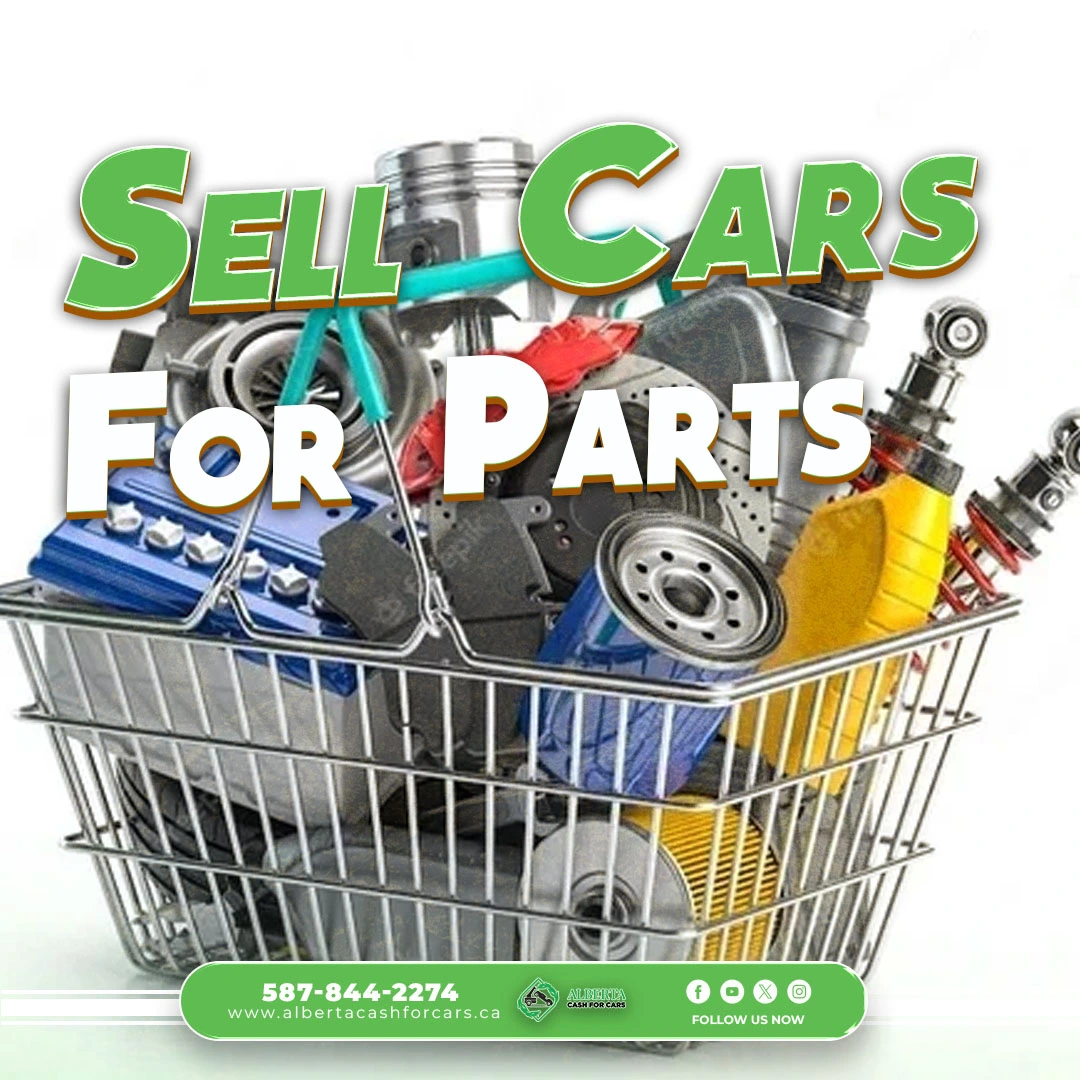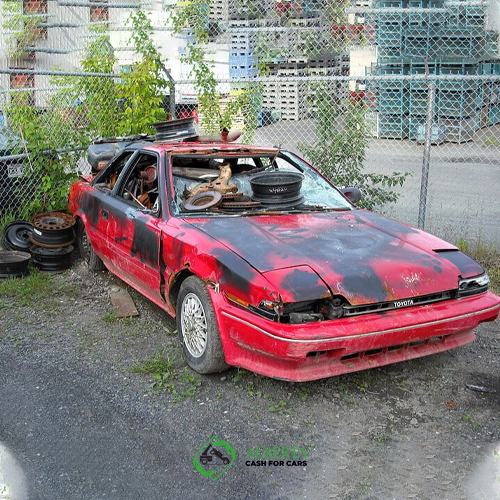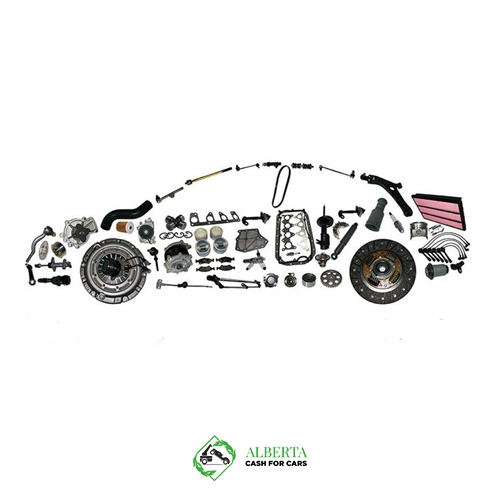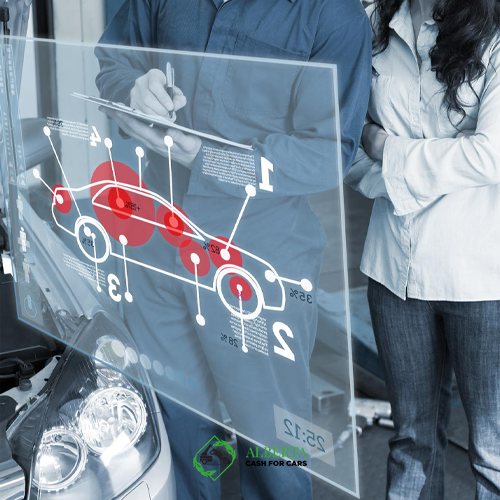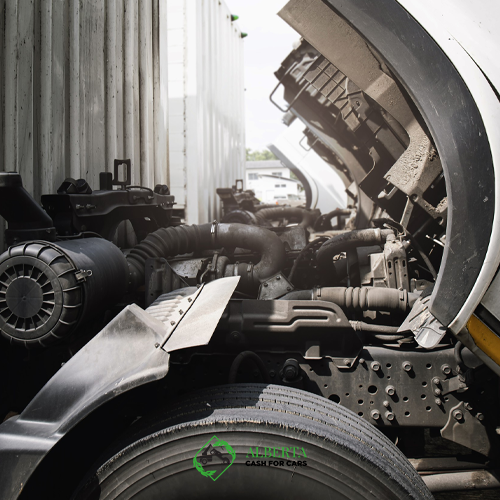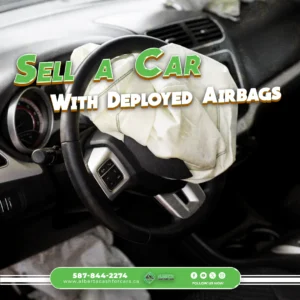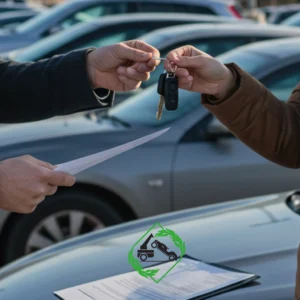Many people avoid sell car for parts because they don’t know how to do it. Sell car for parts can be a very useful way for you to get the most out of your car, especially if you plan to scrap it. In this article, we at Cash for Cars Calgary, have tried to describe a complete guide on how to sell car parts for you so that you can decide whether this is the right option for you or not.
No Hassle, Just Cash — Book Your Free Pickup or Quote Today!
Two options to sell your dead car
If you have come to the conclusion that your car is useless, you can choose one of these two options. Even if your car is not drivable at the moment, you can sell it or you can decide to sell my car for parts. Each of these options is a logical choice. Which choice is better depends on you, your skills, and your circumstances.
We can tell you without any doubt that the quick and easy solution is to sell the car. You can sell it to an individual, a car dealer, a salvage yard, or donate it to a charity. In any of these ways, you can easily get rid of your car. In most cases, the payments will be in cash for you, but if you donate a car, you will probably have a tax deducted from your income. In all these scenarios, you get rid of your car quickly.
If you decide to sell, you should know the approximate value of your car in its condition. Find the value of the used car and then deduct the estimated cost of repairs needed to sell it. By knowing and having this information, you can easily sell your car and get the right offer.
What does it mean to part out a car?
Parting is a simple term in which vehicle parts are taken out and put up for sale. These parts, such as a vehicle engine or door handles, can be big or small. If you have little knowledge about a car’s inner workings, you can do this process yourself instead of a mechanic.
Can I sell my car for parts?
The answer to this question is yes, but you should consider whether the selling value of the parts is more than the selling value of the whole car. Of course, you should remember that selling car parts can take more time than selling a complete car. You should also check a few other things. It is better to get several price offers for your car to evaluate whether it is better to repair and sell it to a private buyer or dealership. In this case, you can find out if it still makes sense to sell the car parts. If the cost of repairs increases or is half the price of a new car, car repair is probably not a logical solution.
How do I sell my car for parts?
It depends on whether you want to do it yourself or a mechanic. If you are going to disassemble the parts yourself, you need to know that you need the tools and skills to be able to do this; then, you can take pictures of the parts and list them for sale. Regarding the time required to remove the parts, it should be said that you need 6 to 8 hours to remove the engine, while you need less time for the interior decorations and seats because the process is easier. Be careful that if you damage the part you are taking apart, its value may decrease to a great extent.
But if you are looking for a simple solution, the best option is to sell your car for parts to scrap yards so that they can do it themselves, but you will definitely earn less money in this solution.
Where should I sell my car for parts?
If you plan to sell your car completely, you can contact scrap yards and junkyards to get a price for your car based on its condition.
You can use online ads to sell individual parts or even sell the whole car. There are special forums that will help you in this way. With their help, you can do this process quickly. It is possible and easier to sell heavier parts locally on sites like Facebook.
eBay is a good site to evaluate the sales of auto parts. You can lower your price to sell faster. This site is also very good for protection in case of any problems.
How much money will I make if I Sell car for parts?
It is not possible to answer this question precisely because you have to be in this situation to know exactly how much your car parts are worth. This process depends on factors such as the make, model, and other conditions of the car. Your car may be a very rare model with very suitable and desirable seats, or your car’s engine may be a type that is rarely sold, or you may have to wait months to sell your car seat. You can check the prices of parts on different sites to get some idea of the prices.
Keep in mind that car for parts sell will take some time, and it may take weeks or even months for everything to sell. It is better to store the parts in a place until they are sold so that they are not damaged. You will earn more money through this method, but you have to consider more time and effort.
What parts of a car are worth money?
Old and junk cars have great parts that are in high demand so that they can generate a lot of income for you. These special and valuable parts are:
Car engine
The heart of your car is its engine, which has a lot of value even if your car is old. Even when it needs to be repaired, you can give it to the restorers and then sell it. A used motorcycle can earn you an average of $1,000 to $3,000.
Gearbox
The gearbox sales market is one of the billion-dollar markets. Because of its importance in power transmission, regulation and control throughout the vehicle is invaluable. Metals such as aluminum, steel, cast iron, and brass make the car’s transmission create a lot of value when disassembling.
Catalytic converter
A necessary part of every vehicle is a catalytic converter that minimizes the amount of emissions produced by the vehicle. Catalytic converters are made of valuable and expensive metals such as platinum, palladium, and rhodium. As a result, this piece is one of the most profitable pieces for sale.
External parts
Another thing that comes up in response to the question ” Is selling car parts profitable” is the exterior parts of the car, replacement parts are important, but auto upgrades after sales are also very important. These parts include side mirrors, wiper blades, steel bumpers, replacement grilles, and the like.
Wheels and tires
Alongside wheels and tires, suspension parts are also in high demand. Most customers are looking for leveling kits, strut lift kits, and shocks to help them replace their wheels and tires.
Lighting and LED products
Bulbs, tail lights, side lights, brake lights, fog lights, trunk lights, license plate lights, and other things are valuable So, we can easily tell you in response to the question, ” Is selling car parts profitable?”, Yes, it is.
The general rule in this process is that the parts that wear out quickly and easily have a high turnover, so the owners have to replace their tires much more often than the old engine parts.
So far, we have told you the parts that have the most demand for sale, but there are other parts that you can make a good profit by selling them. These sections include:
- Rims
- Airbags
- Alternator
- Transmission
- Radiators
- The doors
- Weatherstripping
- Niche items such as vintage auto parts and accessories
- Struts and shocks
- Seat covers
- Programmers and performance chips
- Auto literature and manuals
- Keyless entry fobs and keys
- Ignition system parts, such as plug wires, spark plugs, distributors, coils, and timing kits
- Fuel pumps and filters
- Floor mats
- Exhaust system parts, such as mufflers and cat-back systems
- EGR system components
- Disc brake pad system parts
- Replacement emblems, stickers, and decals
- Dash kits and upgrades (for example, carbon fiber dress-up parts)
- Cylinder heads
- Crate engines
- Clutch kits
- Car battery accessories: jump batteries and chargers
- Air filters
- A/C control systems and compressors
Essential Tools and Equipment for Parting Out a Car
If you are planning to sell car for parts, it is essential to have the right tools and equipment is essential to ensure a smooth, efficient, and safe process. Here’s a detailed breakdown of the tools you’ll need to ensure a successful disassembly.
- Basic Hand Tools: A reliable set of screwdrivers, wrenches, and pliers provides the essential tools for disassembling various components. Invest in a high-quality socket set with metric and standard sizes to handle different bolts. Allen wrenches and Torx drivers are also useful for specialized fasteners found in modern vehicles. These tools allow you to work precisely without damaging parts, increasing their resale value when you sell car for parts.
- Jack and Jack Stands: To access parts underneath the car, such as the transmission, exhaust, or fuel tank, you’ll need to lift the vehicle. A hydraulic floor jack provides quick and stable lifting, while jack stands ensure safety by maintaining the car securely elevated. Always use jack stands instead of relying solely on the jack, as this reduces the risk of accidents during disassembly.
- Pry Bars and Mallets: Over time, parts can become stuck due to a number of factors, including rust, debris, or tight fittings. Pry bars help you separate stubborn components like brake rotors or suspension parts without damaging them. Rubber mallets are ideal for gently tapping components free without scratching or denting them, which is essential when you plan to sell car for parts in good condition.
- Battery-Powered Tools: Cordless drills and impact wrenches are invaluable for working on a car. They allow you to remove bolts, screws, and other fasteners quickly, saving both time and energy. For heavy-duty tasks, such as loosening lug nuts or engine mounts, a powerful impact wrench is essential. These tools speed up the process, helping you efficiently prepare parts for resale.
Is it better to part out your car or sell it whole?
Selling car parts is a very good solution to earn a great income. But there may be disadvantages in this way. If you are one of those people who do not have the necessary expertise and tools for this work, removing the parts may not be in your best interest. If time is important to you and you want to make money quickly, selling parts individually may take a lot of time. In this situation, it is generally better to sell the car. Remember that damage to vital parts such as the engine, transmission, and other items reduces the value of the vehicle, so to get the most income, it is better to have your car healthy and have all the important parts.
Benefits of parting out a vehicle versus selling it as a whole
Selling your car for parts rather than as a whole vehicle comes with several distinct benefits, making it a strategic choice for those looking to maximize value and streamline the selling process. The phrase “selling your car for parts” encapsulates the essence of this approach, emphasizing the advantages that stem from dismantling a vehicle for individual components.
One primary benefit of car for parts sell is the potential for increased overall returns. By carefully assessing the condition of the vehicle and identifying valuable components, you can create a comprehensive inventory of parts that may fetch higher prices individually than the entire vehicle would as a whole. This targeted approach allows you to capitalize on the market demand for specific car components, maximizing your profit in the process.
Additionally, there is a more environmentally conscious option if you want to sell your car for elements. Parting out the car facilitates the recycling and reuse of salvageable sections rather than sending the entire thing to a junkyard, where it can add to automotive waste. This environmentally friendly method lessens the impact of disposing of automobiles on the environment, which is in line with the increasing focus on sustainability.
Furthermore, the process of car for parts sell offers a level of flexibility and customization not found in selling the vehicle as a whole. Buyers often have specific needs, seeking individual parts to repair or upgrade their vehicles. By catering to this demand, you can tailor your offerings to match the market, attracting buyers who may not be interested in the entire vehicle but find value in specific components.
Selling your car for parts also simplifies the selling process, particularly if the vehicle has significant wear and tear or mechanical issues. Instead of negotiating the sale of an entire car with potential buyers, you can focus on marketing and selling individual parts, streamlining the transaction process and potentially expediting the overall sale.
The decision to consider car for parts sell is a strategic one, offering financial benefits, environmental responsibility, and a tailored approach to meet market demand. Embracing the concept of “selling your car for parts” allows sellers to unlock the hidden value within their vehicles while contributing to a more sustainable and efficient automotive ecosystem.
How to get a fair price when sell my car for parts?
If you don’t know the true value of your car, you may find it difficult to find a good price for your car. That’s why it makes sense to check used parts prices for your specific car’s year, make, and model. You can check this issue online from several sources and sell them at the price of parts that are suitable.
After checking the prices, make a detailed list of the parts you want to sell. Make sure your items are clean and take pictures from several different angles to show the actual condition of the item you are selling. After you complete your listing, you can post items for sale on multiple sites.
How to Photograph of a Car for Parts Sell
High-quality images are essential car for parts sell online. Good photos can significantly increase your chances of attracting potential buyers and making a sale. Here’s how to take great pictures of your car for parts sell:
- Choose a clean, well-lit background: A simple, neutral background will help the part stand out. Natural light is often best, but you can also use artificial lighting.
- Focus on the part: Take close-up shots of the part from different angles. Capture any damage or wear and tear honestly.
- Show the part number: If the part has a number, include it in the photo. This will help buyers verify that the part is correct for their vehicle.
- Use a good camera or smartphone: Most modern smartphones take excellent photos. However, a DSLR camera can produce even better results.
- Optimize image size: Ensure your images are large enough to be seen clearly but not too large to slow down loading times.
By following these tips, you can create professional-looking photos that will help you to find customer for your car for parts sell faster. Remember, the better your photos, the more likely you are to attract buyers and get a good price for your car for parts sell.
Navigating the Alberta Market: How to Sell My Truck Alberta Effectively
When considering how to sell my truck Alberta, it’s crucial to understand the unique dynamics of the local market. Alberta’s diverse landscape and industries mean that truck values and demand can vary significantly. Whether you’re dealing with a rugged work truck or a well-maintained personal vehicle, strategic planning is essential. Start by assessing your truck’s condition and researching comparable sales in the region. Online platforms, local classifieds, and specialized truck forums can provide valuable insights into current market trends. Highlight any unique features or upgrades that could increase your truck’s appeal to Alberta buyers, such as four-wheel drive, towing capacity, or aftermarket accessories. Consider the timing of your sale, as demand may fluctuate seasonally. For a streamlined and efficient process, consider partnering with reputable buyers like albertacashforcars.ca. We understand the Alberta truck market and offer competitive cash offers, handling all the paperwork and logistics. This approach not only saves you time and effort but also ensures a fair and hassle-free transaction. By understanding the local market and leveraging the right resources, you can maximize your return and efficiently navigate the process of how to sell my truck Alberta.
Understanding the reasons behind parting ways with your truck
Deciding to part ways with your truck is a significant decision that often involves a combination of practical, financial, and personal considerations. Understanding the reasons behind “sell my truck for parts” choice is crucial for ensuring a smooth transition and maximizing the value of your vehicle.
- Mechanical Issues: One of the primary reasons for “sell my truck for parts” is the presence of extensive mechanical issues or irreparable damage. If the cost of repairs exceeds the truck’s market value or if it no longer serves its intended purpose, opting to sell it for parts becomes a practical choice.
- Age and mileage: Trucks, like any other vehicle, wear and tear over time. Maintenance costs can grow as a truck matures and collects a high mileage, making it financially unsustainable to keep the vehicle on the road. Owners can recuperate some value from the various components by selling them for parts.
- Upgrade or Lifestyle Change: Lifestyle changes or the desire for an upgrade can also drive the decision to “sell my truck for parts”. Whether it’s transitioning to a more fuel-efficient vehicle, downsizing, or adapting to a new living situation, selling the truck for parts enables owners to free up space and resources for their evolving needs.
- Financial Considerations: Financial strain, unexpected expenses, or the need for quick cash may prompt owners to sell their trucks for parts. This approach allows for a more immediate injection of funds compared to the potentially lengthy process of selling the entire vehicle.
- Environmental Consciousness: Some individuals choose to sell their trucks for parts as part of an environmentally conscious decision. By recycling and reusing functional components, they contribute to reducing the overall environmental impact of automotive waste.
- Customization Projects: Enthusiasts and DIYers may decide to sell their trucks for parts as a way to fund or kickstart customization projects. Selling individual components, such as specialized rims, upgraded suspension, or unique accessories, can help finance these ventures.
Understanding the reasons behind parting ways with your truck allows you to approach the selling process with clarity and purpose. Whether it’s to address mechanical issues, adapt to changing circumstances, or contribute to environmental sustainability, selling a truck for parts can be a practical and strategic decision.

